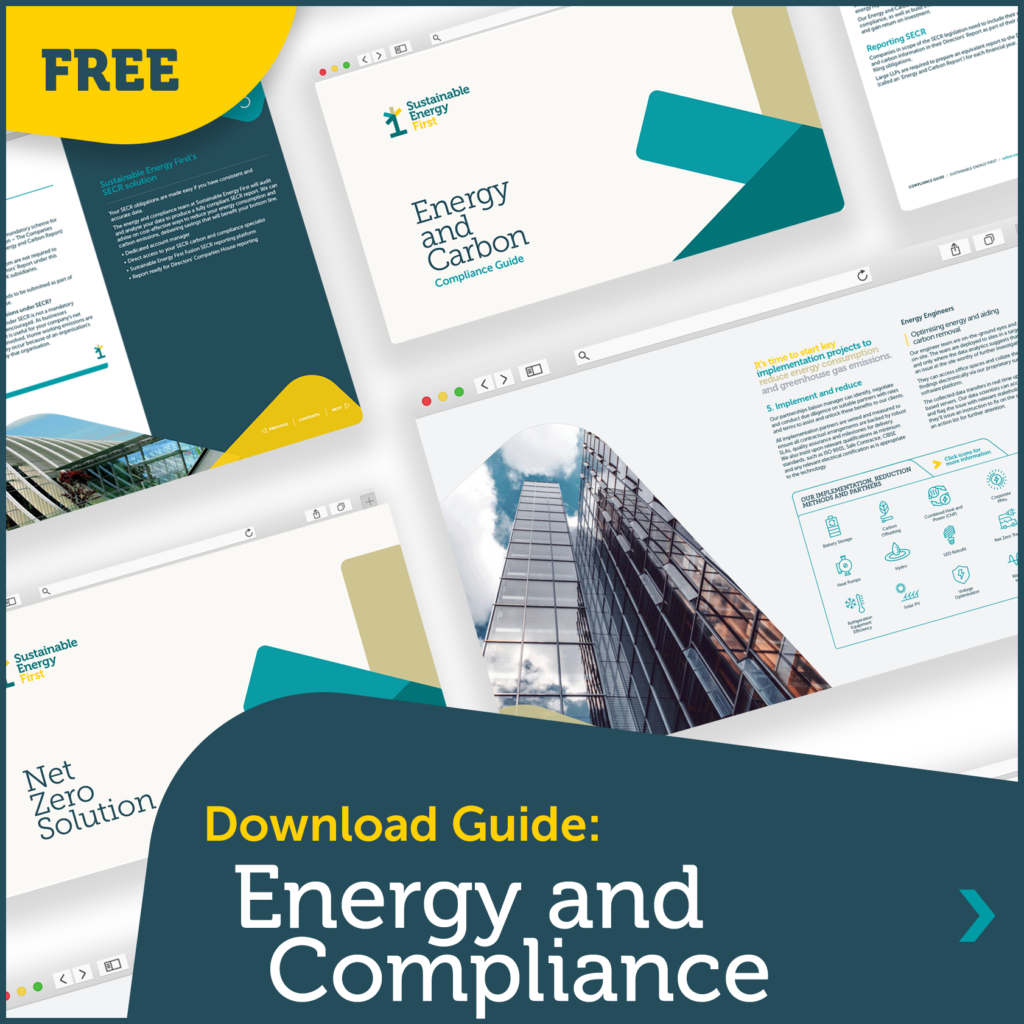We’ve put together the most frequently asked questions on ESOS, to help you meet compliance.
The Energy Savings Opportunity Scheme (ESOS) is a government scheme that requires businesses to identify energy-saving opportunities. It is mandatory for UK businesses over a certain size. Businesses in scope must carry out an audit of their energy use every four years in order to identify potential energy-saving measures. ESOS runs in four-year phases and we are currently in Phase 4, which began on 6 December 2023. Some businesses have yet to complete their obligations under Phase 3. The scheme administrator is currently monitoring non-compliance, so you are advised to submit your notification as soon as possible. Get in touch with our ESOS team if you need support.
Your business will have to comply with ESOS Phase 4 if it meets the following requirements on the qualification date of 31 December 2026:
- At least 250 employees;
- A balance sheet of at least £18 million;
- Turnover of at least £36 million.
The requirements for Phase 3 were different.
- At least 250 employees;
- A balance sheet of at least £38 million;
- Turnover of at least £44 million.
If your business met this definition on the Phase 3 qualification date of 31 December 2022, you should have already submitted your reporting for ESOS Phase 3. If not, you will need to comply as soon as possible to avoid enforcement action.
At the time of writing (September 2024) we don’t have an up-to-date figure on this. The most recent official figure is 11,900. This is based on the number of compliance notifications from Phase 2, which closed in 2019. The Department for Energy Security and Net Zero (DESNZ) has told the Energy Advice Hub that they will update this figure in 2024 after counting the Phase 3 compliance notifications. However, the balance sheet and turnover thresholds have lowered between Phases 3 and 4, so the true figure for businesses in scope of Phase 4 will be higher.
Yes, because non-profits can still be big enough to qualify. Charities, trusts and unincorporated associations may also meet the criteria.
No. If your organisation is a public body as defined by the Public Contracts Regulations 2015 or the Public Contracts Regulations (Scotland) 2015, then you are exempt from ESOS. But it is not always straightforward to determine, particularly for higher education bodies. Most universities are public, but some could be in scope if they self-declare as private and are large enough to be over the size threshold.
Section 1.2 of the official guidance, Who does not qualify for ESOS, has a summary of how the regulations define a public body, but also recommends that you should seek legal advice if unsure.
In Phase 3 there were exemptions for a tiny minority of organisations. If they had no physical assets or employees using energy, they could get a board member to confirm that the organisation was “zero energy” and notify the Environment Agency of this. (This is obviously a very rare scenario.)
There were also lighter requirements for organisations with a total consumption of below 40,000kWh; they did not have to have their assessment reviewed by a lead assessor.
We do not yet know what exemptions, if any, will exist in Phase 4.
If any UK-registered part of an overseas company meets the ESOS qualification criteria, then ESOS applies to all UK-registered branches of the company. (Meeting the criteria means employing 250 or more people, or having a turnover above £36 million and a balance sheet over £18 million.)
Where a corporate group participates in ESOS, then usually the highest UK parent company acts as the “responsible undertaking” and takes responsibility for the ESOS compliance of the whole group.
Many large multinationals have complex legal structures, so you may need to seek expert advice when assessing if your business qualifies.
ESOS runs in four-year cycles, or phases. We are currently in Phase 4, which began on 6 December 2023.
The deadline for submitting a Phase 3 compliance notification was extended twice, most recently to 6 August 2024, after IT problems with the notification system.
Phase 3 also requires participants to submit an ESOS action plan, with a deadline of 5 December 2024. However, due to delays in getting the digital submission system up and running, the Environment Agency has announced it will accept plans up to 5 March 2025. Action plan functionality is now live within the MESOS system – you will need a registered organisation account to make a submission.
Before you can submit your action plan you are required to have submitted your notification of compliance. If this was not submitted by the deadline (6 August 2024), you may be at risk of enforcement action and should contact the Environment Agency immediately.
Each ESOS phase has two key dates: the qualification date and the compliance date.
The qualification date for Phase 3 was 31 December 2022.
The (extended) deadline for Phase 3 compliance passed on 6 August 2024. The Environment Agency is pursuing non-compliant organisations.
The official deadline for submitting your Phase 3 ESOS Action plan is 5 December 2024 but the Environment Agency will accept plans up to 5 March 2025.
The qualification date for Phase 4 is 31 December 2026. If your organisation meets the size criteria on that date, you will be in scope of ESOS.
The compliance date for ESOS Phase 4 is currently 5 December 2027.
ESOS is a UK government scheme administered by the Environment Agency. Each country of the UK has a different regulator to handle ESOS compliance and enforcement.
- England: the Environment Agency
- Wales: Natural Resources Wales
- Scotland: the Scottish Environment Protection Agency
- NI: the Northern Ireland Environment Agency
- Offshore (businesses whose activities are wholly or mainly offshore): the Secretary of State for Energy Security and Net Zero
There are various ways in which an organisation in scope can fail to meet its ESOS obligations. These include, but are not limited to:
- Failing to submit a compliance notification by the deadline;
- Failing to carry out an energy audit;
- Carrying out a poor quality audit;
- Keeping incomplete or inaccurate records;
- Publishing false information in your records.
The consequences of not meeting your ESOS obligations vary depending on how exactly your organisation falls short. For Phase 2, roughly two-thirds of organisations found themselves “compliant with remedials” – that is, broadly compliant but required to take action to bring their reporting up to the right standard.
A much smaller proportion (7% of organisations in scope) were deemed non-compliant in Phase 2. This can incur a serious financial penalty. The Environment Agency has the power to impose fines of up to £50,000 as well as fresh fines for each day that it takes the organisation to remedy the situation.
The Environment Agency’s dataset of civil penalties relating to climate schemes suggests (at the time of writing in September 2024) that no fines have been levied yet in relation to ESOS Phase 3. (The most recent data comes from Phase 2 and shows 105 civil penalties amounting to £1,487,410.) But the Energy Advice Hub has it on good authority that the Environment Agency is currently pursuing non-compliant organisations.
As far as we know, for Phase 4 the route to ESOS compliance goes roughly like this:
- Carry out an audit of your organisation’s energy use in all areas (or get a qualified external person to do this for you).
- Identify all feasible opportunities for energy-saving measures in the audit report.
- Get a qualified lead assessor to approve your report (if they didn’t write it in the first place).
- Ensure that your report reaches one of the required reporting standards (to be confirmed later in Phase 4).
- Create a net zero assessment: when is your organisation aiming to reach net zero emissions, how will it get there and what are the milestones along the way?
- Consider your list of possible efficiency measures in the light of your net zero plan and make decisions about which to take forward (and when). This is your ESOS action plan.
- Begin actually implementing your action plan and publishing progress.
In Phase 3, it was possible to use the ISO 50001 standard as an alternative route to ESOS compliance, provided that at least 95% of your total energy use was covered by this. It seems likely that ISO 50001 will remain an ESOS compliance route in Phase 4 as well.
The official ESOS guidance explains the process of carrying out an energy audit:
- Measure your total energy consumption over a 12-month period.
- Identify areas of significant energy consumption (at least 95% of your total energy consumption).
- Calculate your energy intensity ratios.
- Consider available routes to compliance.
- Ensure areas of significant energy consumption (or total consumption) are covered by a route to compliance.
- Appoint a lead assessor. (There is an exception for the minority of organisations that have zero energy responsibility under the ESOS rules.)
- Complete the ESOS report.
- Share the report and relevant documentation with group undertakings.
- Get one or more board level directors to review the findings of the assessment.
- Submit your notification of ESOS compliance through the Environment Agency website.
- Complete an action plan. (The deadline for Phase 3 action plans is 5 March 2025.)
- Provide two annual progress reports in the two years following the action plan deadline.
- Keep records: your compliance notification, a copy of your ESOS report and any other relevant documentation.
ESOS reporting makes a distinction between your organisation’s total energy consumption and its significant energy consumption. Both require you to choose a reference period of 12 consecutive months, but it doesn’t have to be the same 12 months for both types of consumption.
For total energy consumption, your reference period for Phase 4 must include the qualification date of 31 December 2026 and end before the compliance deadline of 5 December 2027. So the earliest it could start is 1 January 2026 and the latest it could end is 4 December 2027. You can pick any consecutive 12 months within that timespan of just over 23 months.
For significant energy consumption, you can take any consecutive 12 months of data from between 6 December 2023 (when Phase 4 started) and 5 December 2027. But the data should be no older than 24 months by the time you do the audit (so for an audit carried out on 1 January 2025, the data should not be from any earlier than 1 January 2023).
In practice, it is much more straightforward to use the same reference period for both categories of consumption.
Your ESOS energy consumption calculation should include all sources of energy consumption, including building use and transport. You must use the same unit of measurement for all your calculations: either an energy unit such as kWh, or energy spend in pounds sterling. (It isn’t acceptable to record your energy consumption in terms of CO2 or CO2 equivalent, because these are not measures of energy.)
The government publishes tables of conversion factors that allow you to calculate the kWh for each litre of petrol burned in your company vehicles. Alternatively, you can state your company’s petrol and diesel consumption in terms of spending and give the calculations in pounds sterling.
Don’t forget that since Phase 3 you have also been required to include an energy intensity metric. For the energy use relating to your company’s buildings, this might be kWh/m2, while for transport energy it might be kWh per mile travelled. You should also use one or more energy intensity metrics relating to the output of your business, such as kWh per hundred customers served or kWh per £100 of turnover.
Your initial calculations will cover all sources of energy consumption, but when doing the full audit you are allowed to exclude specific areas of organisational activity. This might mean leaving out a specific site, or consumption relating to a particular activity or fuel. These excluded areas can be up to 5% of your total consumption. The excluded proportion of energy use is known as your de minimis.
You obviously still have to calculate the excluded energy use, in order to ensure it is below the 5% threshold and state exactly what percentage it is in your ESOS reporting. But you will not get any energy-saving recommendations for it. For this reason, many businesses skip the de minimis option and simply include all their consumption; if you have to measure it anyway, you might as well get the benefit of doing that work.
The de minimis rule is the same if you are following alternative routes to Phase 3 compliance such as ISO 50001 certification.
No. You must carry out site visits as part of your ESOS energy audit, but you don’t have to visit every site in your organisation.
You can instead take a sampling approach, whereby you split your portfolio into different building types, e.g. office, warehouse, retail etc and visit one of each. You can apply the findings to the rest of the sites that are identical or very similar.
At the moment, best practice for the sampling approach is not prescribed in the ESOS legislation and it is up to the organisation to work out the approach that will give the most accurate calculations of its energy use. The guidance recommends working with your lead assessor to develop a suitable approach that accurately reflects the energy consumption patterns of your organisation’s assets and activities. You should explain your methodology in your ESOS evidence pack.
Your ESOS reporting must be signed off by an officially approved ESOS lead assessor. It is fine if this person is an employee of your organisation, provided that they are on one of the approved registers for ESOS lead assessors.
The lead assessor may carry out all the energy audits and reporting themselves, or you may get others to do this work and then bring the lead assessor in to check that it meets the ESOS requirements.
The official ESOS guidance includes a list of approved registers for ESOS lead assessors. At Sustainable Energy First, we have a team of qualified and certified ESOS lead assessors, accredited by the Association of Energy Engineers, the Energy Institute and CIBSE.
A government evaluation of ESOS Phase 1 found that businesses spent on average 15 days of staff time on their Phase 1 data-gathering and reporting. This may be lower in later phases, now that organisations in scope know what is involved and are used to collating their energy usage information.
Unsurprisingly, larger and more complex organisations tend to need more time for ESOS compliance activity than smaller ones.
The most time-consuming part of ESOS compliance tends to be supporting the lead assessor by supplying the information requested, accompanying them on site visits and so on.
A government factsheet from September 2023 estimates that the costs of ESOS audits have been between £6,000 and £15,000 over the four years of an ESOS phase. It further estimates that the cost of adding a net zero element for Phase 4 onwards will be between £600 and £7,500 per audit.
Under ESOS, energy is defined as all forms of energy products, including:
- combustible fuels
- heat (excluding your organisation’s surplus heat from industrial processes)
- renewable energy
- electricity
- fuel used in transport
There are no fuel type exemptions in ESOS, although some consumption may be deemed de minimis and therefore excluded from the report.
You only need to include data on transport that your company operates, e.g:
- Fuel used in company cars on business use
- Fuel used in fleet vehicles which you operate on business use
- Fuel used in personal/hire cars on business use
- Fuel used in private jets, fleet aircraft, trains, ships, or drilling platforms which your organisation operates.
If your employees take trains, flights or taxis for business use, that are not operated by the company, then you don’t need to report on these. You also don’t need to report on fuel used by subcontractors in transporting goods.
For advice on how to start gathering transport data, read our guide.
The point of ESOS is to help organisations identify opportunities for energy saving that they can actually act on. This means ESOS focuses only on the energy use your organisation controls.
So tenants in a building should take responsibility for the energy they consume through the operations of that business, but not for energy use associated with shared areas of the building such as lifts, heating and so on.
The most useful tool for separating out the different areas of energy use is sub-metering. Sustainable Energy First has extensive experience of helping organisations use sub-metering to take control of their energy use. To find out more, get in touch.
There is still no requirement for ESOS data to be presented in any particular way. However, there is an offline Excel template that you can follow to produce your ESOS Action Plan (get in touch with us if you’d like a copy). This template is provided as a tool that organisations may wish to use to help them collect the information required to complete their Action Plan submission.
With mandatory net zero reporting coming in Phase 5, it is likely that templates will be introduced to ensure data is presented in a specific way. Whatever the eventual templates look like, they will definitely require participants to keep clear records of how they have met the ESOS requirements. The more clarity, detail and structure your records have, the easier it will be for your organisation to comply with whatever is coming in future.
The whole point of ESOS is to identify possible energy savings and then carry out whichever measures are practical and good value for money. To get the most financial benefit from your ESOS audit, it’s a good idea to select an ESOS lead assessor who is also capable of helping you to implement the identified energy saving measures.
Sustainable Energy First can connect you with a lead assessor who will help build a cost-effective carbon reduction strategy and gain a return on investment from your ESOS audits.
Some companies offer a ‘shared savings’ energy efficiency scheme, whereby the upfront cost of an energy saving project is covered by the supplier or a third-party financing company. The customer then repays the cost through an agreed percentage of the energy savings achieved.
This means that energy efficiency projects can be cost neutral for an organisation in the short term, while bringing savings in the long term through lower energy bills. Your lead assessor may have a similar offer or be able to recommend a company that offers such a scheme.
It is not compulsory to carry out all the energy-saving measures identified by your audit. But to complete your Phase 3 compliance you do need an ESOS action plan explaining what you are committing to do over the next four years. This should include:
- What you intend to do to reduce your organisation’s energy consumption;
- When you intend to do it;
- Whether it was recommended through your ESOS assessment;
- What energy savings you expect to see by carrying out your action plan;
- How you estimated those energy savings.
The deadline to submit your Phase 3 ESOS action plan is 5 March 2025.
You will then need to provide annual progress updates on these actions. Your plan and progress updates must be made public.
It is perfectly lawful to decide that your organisation will take no action at all, but if so, you will need to submit an official notification confirming this. This will be made public, so your organisation needs to consider the reputational risk of being seen to do nothing.
Your evidence pack for ESOS compliance should contain the following:
Organisational info
- Contact details of the organisation doing the ESOS reporting;
- Details of any board-level directors or equivalent who have reviewed the ESOS assessment findings;
- A written agreement on how you chose to disaggregate or aggregate group members when setting the boundaries of the corporate body for ESOS purposes;
- If your “responsible undertaking” is anything other than the default option of the highest UK parent company, you need to show a written agreement about how this was decided.
ESOS assessment info
- The calculation of your total energy consumption and primary evidence for how you worked it out;
- A list of your identified areas of significant energy consumption;
- Calculations of your energy intensity ratios, e.g. kWh per unit produced;
- Details of the energy audits undertaken, including the audit methodology used in your ESOS energy audits;
- Details of the energy-saving opportunities identified;
- Details of the routes to compliance used to cover each area of significant energy consumption and, where applicable, evidence (e.g. certificates) of the alternative routes to compliance;
- Details of energy savings achieved during the compliance period
- A copy of your ESOS report;
- Written confirmation from the lead assessor that they reviewed the ESOS assessment;
- Contact details of your lead assessor and the name of the approved register of which they are a member;
- Written confirmation from the director(s) to show that they have reviewed the ESOS assessment;
- A copy of your compliance notification submission. (This will be available to download through the compliance notification portal once it is up and running.)
Action plan info
- A copy of your ESOS action plan
- Copies of every subsequent annual progress update
- Written confirmation from the directors that they reviewed the plan and progress updates.
Explaining gaps
Your organisation should do everything possible to follow ESOS best practice. But if you have fallen short in any area, your evidence pack should explain why. For example:
- If you couldn’t provide a full 12 months of data, the reasons why not;
- If your lead assessor has not used an energy consumption profile in your audit of an area of significant energy use, the justification for not doing so.
- If you didn’t use verifiable data on energy use or energy expenditure to support your calculations, the reasons why you couldn’t.
Your methodology for calculating or estimating energy use should be clear from your evidence pack.
You must keep the evidence pack for the compliance period to which it relates and the two subsequent compliance periods.
It is up to your organisation to choose which measures to carry out and how to prioritise the ones you have chosen. But your lead assessor should have helped you with this decision-making by giving you information on cost-effectiveness, ease of implementation and so on. Some lead assessors may also be able to help you move forward with the actual work, and it is a good idea to select one with this capability. (At Sustainable Energy First, we can fulfil the lead assessor role and also help you gain the best return on investment from your energy efficiency measures.)
Some energy efficiency measures have a good return on investment but cost a lot upfront. It is your organisation’s own decision how to fund this kind of measure. Some companies offer a “shared savings” finance model, where the supplier or a third-party finance company covers the cost of the work, then the organisation repays the cost through an agreed percentage of the energy savings achieved. Your lead assessor should be able to advise you on the best options for financing your energy efficiency work.
Although nobody welcomes more paperwork, there is a reason why the scheme has “opportunity” in the name. It was designed to help organisations cut their carbon footprint and energy bills in a cost-effective way. Much of the benefit from ESOS will be felt directly by businesses in the form of cost savings. But there are other benefits too, mainly a reduction in the UK’s carbon emissions and an improvement in air quality.
Businesses have been slower to implement energy-saving measures than the government originally envisaged, which means we are not yet experiencing the full benefits. This is why the government is taking steps to strengthen the scheme. A July 2021 impact assessment estimated that the strengthened scheme in future could have a value to society of £1 billion, with £907 million of this value going to UK businesses.
Originally, there were plans to introduce mandatory net zero reporting in ESOS Phase 4. However, due to delays to the introduction of Phase 3 legislation and guidance during the pandemic, mandatory net zero reporting will not come into effect until Phase 5, which will run from 2027 to 2031.
While Phase 4 requirements have yet to be finalised, the Environment Agency has issued a number of updates that give businesses a good idea of what they can expect. Read our ESOS Phase 4 guidance to ensure you’re on track to meet the compliance deadline of 5 December 2027.
Business guide to UK energy and carbon compliance
As well as articles, FAQs and explainers, we also produce a number of FREE guides that are available to download. We have just updated our Energy and Carbon Compliance guide making it as current and relevant as possible to readers.

Our guide to mandatory energy and carbon compliance schemes in the UK is essential reading for anyone responsible for energy, sustainability, or compliance.
We also cover the wide range of voluntary schemes that can help you achieve best practice in your organisation.
If the content of this or any of our pages has interested you, please get in touch for a no-obligation chat with our industry-leading experts at Sustainable Energy First.









